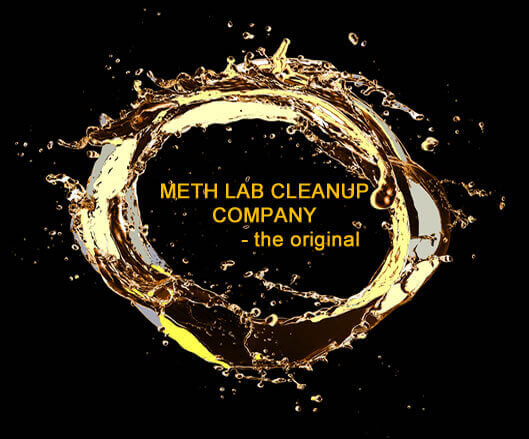TYPES OF METH RESIDUE ANALYSIS
METH TESTING CONSIDERATIONS
Landlord/tenant laws require that landlords maintain a property that is free from hazards. Landlords must also comply with the health and safety codes of the city or county in which the property is located. If methamphetamine or meth production chemicals are suspected and/or identified, the property owner must assume responsibility for testing and decontamination. Illegal drug operations on rental properties can cause a loss of rent, civil penalties, damaged property, decline in property values, dangerous, threatening tenants, resentful and angry neighbors.
Background checks are one of the best mechanisms to protect your investments. Regularly drive by the property, schedule visits with tenants and talk with neighbors. Make sure your rental property is properly insured. Clandestine drug lab damage and contamination is often covered under malicious mischief or vandalism, although some policies do have exclusions for illegal drug activity. Understand you state's clandestine drug lab laws and disclosure laws. For a comprehensive source of state clandestine drug lab laws go here. If you suspect a drug lab on your property, do not enter the property, contact local law enforcement. If problems do arise, call Meth Lab Cleanup Company 800-959-6384; an experienced, certified clandestine drug lab testing and decontamination firm.
If you are considering purchasing a home you will want to learn as much as you can about the house before you buy it. It may be the largest investment you will ever make. To minimize unexpected costs or difficulties, a comprehensive home inspection is crucial. The inspection may identify the need for repairs, builder oversights or maintenance issues. Once the inspection is complete and the information is provided, you can make decisions with the confidence you have the facts. Many home inspectors are now offering meth testing services for an additional fee. Fees vary but are usually based on the number of samples taken. You can also test a prospective home for meth yourself with AccuMeth® do-it-yourself meth test kits. For comprehensive results, it is recommended that you purchase at lest one sample kit for each room.
We make excellence a habit
Which method should you choose?
The difference between the GC/MS, LC/MS and immunoassay methods is the type of information (data) obtained. Meth Lab Cleanup's AccuMeth® brand meth test kits are specific to detection levels at the most recognized legal standards for methamphetamine residue of 0.1 ug/100cm2, 0.5 ug/100cm2 and 1.5 ug/100cm2.
IMMUNOASSAY - ONSITE, IMMEDIATE METH RESIDUE SAMPLING - METHOD USED IN on-site AccuMeth® Brand Meth Test Kits
An immunoassay is a biochemical test that measures that presence or concentration of a macromolecule in a solution through the use of an antibody. The macromolecule detected by the immunoassay is often referred to as an "analyte." Immunoassay come in many different formats and variations. Immunoassays may be run in multiple steps with reagents being added and washed away or separated at different point in the assay.
The use of a calibrator is often employed in immunoassays. Calibrators are solutions that are known to contain the analyte in questions and the concentration of that analyte is generally known. Comparison of an assay's response to a real sample against the assay's response produced by the calibrators makes it possible to interpret the signal strength in terms of the present of concentration of analyte in the sample.
GAS CHROMOTOGRAPHY/ MASS SPECTROMETRY (GC/MS) - laboratory analyzed meth samples
Gas chromatography-mass spectrometry (GC/MS) is a method that combines the features of gas-liquid chromatography and mass spectrometry to identify different substances within a test sample. Applications of GC/MS include drug detection, fire investigation,environmental analysis, explosives investigation and identification of unknown samples.
GC/MS can be used to confirm positive immunoassay results. When the specific amount of methamphetamine residue on-site is needed, then the use of GC/MS by an accredited laboratory is an option. In most cases, GC/MS are calibrated to quantify methamphetamine at a concentration of 0.02 ug. The Black Box Reader® can also be used to quantify immunoassay results. The Reader can detect meth residue on AccuMeth® brand cassettes to + or - 50 ng of the target legal standard.
Liquid chromatography / mass spectrometry (LC/MS) - laboratory METHOD USED IN METHASSURE® Brand Meth Test Kits
Liquid chromatograph-mass spectrometry (LC/MS) is a chemistry technique that combines the physical separation capabilities of liquid chromatography with mass analysis capabilities of mass spectrometry. LC/MS is a powerful technique used for many applications which has very high sensitivity and selectivity.
Generally its application is oriented towards the general detection and potential identification of chemicals in the presence of other chemicals (in a complex mixture). Preparative LC/MS systems can be used for fast and mass directed purification of natural-products extracts and new molecular entities important to environmental, food, pharmaceutical, agrochemicals and other industries.
